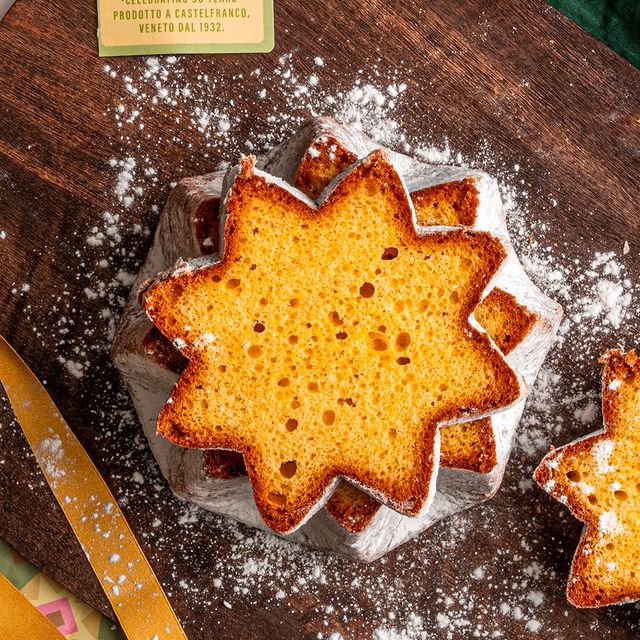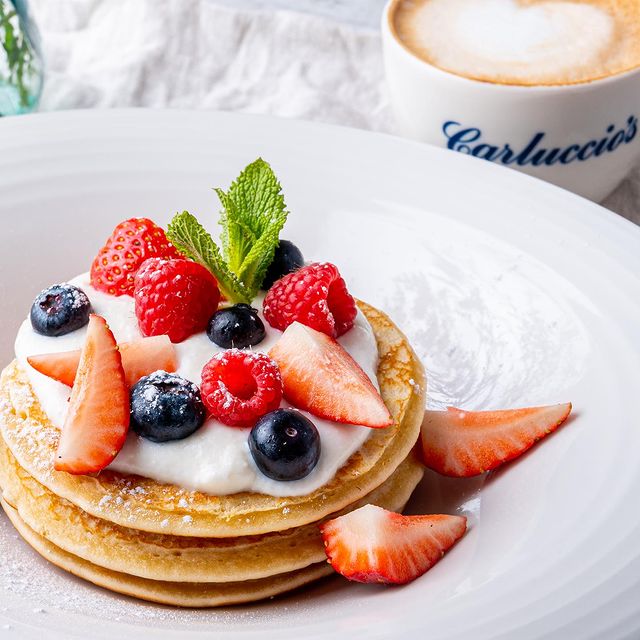Pandoro — The Golden Star of Italian Christmas
When it comes to Italian Christmas desserts, two giants dominate the festive table: Panettone and Pandoro. While Panettone, with its distinct dome shape and fruit-studded interior, often steals the global spotlight, its elegant, golden counterpart, Pandoro, holds an equally cherished place in the hearts of many Italians. Join Carluccio's as we delve into the wonders of Pandoro – what it is, how it differs from Panettone, and where its origins lie.
What is Pandoro?
Pandoro, whose name literally translates to "golden bread" (pan d'oro), is a light, airy, and incredibly rich sweet bread, traditionally enjoyed during the Christmas season in Italy. It's instantly recognisable by its unique truncated conical shape with an eight-pointed star cross-section – a design that makes it resemble a snow-capped mountain when dusted with its accompanying sachet of vanilla-scented icing sugar.
The magic of Pandoro lies in its simplicity and the masterful execution of its ingredients: flour, eggs, butter, sugar, and yeast. Unlike many other festive cakes, it typically contains no candied fruit, raisins, or nuts. This minimalist approach allows the pure, delicate flavour of the buttery, vanilla-infused dough to shine through, offering a melt-in-your-mouth experience that is both comforting and luxurious. The extensive leavening process, often involving multiple stages and long rising times (sometimes up to 36-38 hours), contributes to its signature fluffy texture.
Pandoro vs. Panettone: The Sweet Showdown
While both Pandoro and Panettone are beloved Italian Christmas cakes, they are distinct in their characteristics, sparking friendly debates across Italy:
-
Shape: This is perhaps the most obvious difference. Panettone is tall and cylindrical with a domed top, while Pandoro boasts its iconic star shape.
-
Ingredients & Flavour Profile: Panettone is defined by its inclusion of candied fruits (orange peel, citron) and raisins, which give it a more complex, aromatic, and often slightly chewy texture. Pandoro, on the other hand, is a purist's dream – no fruits or nuts, just the pure, rich taste of butter and vanilla, resulting in a softer, more delicate crumb.
-
Texture: Due to the fruit, Panettone tends to be denser and more crumbly. Pandoro is celebrated for its incredibly light, airy, and almost sponge-like consistency that practically dissolves in your mouth.
-
Serving: Pandoro is almost always served dusted with a generous snowfall of powdered sugar, often shaken in its bag to coat every peak and valley. Panettone is typically served plain, though both can be accompanied by creams or sweet wines.
Where is Pandoro From?
Pandoro's origins are firmly rooted in the romantic city of Verona, in the Veneto region of northern Italy. While sweet breads and "golden breads" existed in the region for centuries (some theories even link it to a 13th-century Veronese cake called Nadalin), the Pandoro we know today was officially patented by Veronese baker Domenico Melegatti on October 14, 1884.
Melegatti's genius lay in refining existing local traditions and creating a commercially viable, distinct product. He incorporated the eight-pointed star shape, said to be inspired by the Star of Bethlehem and designed by impressionist painter Angelo Dall'Oca Bianca. The name "Pan d'oro" itself might also harken back to a 16th-century conical cake from the Republic of Venice, which was sometimes decorated with gold leaf for aristocratic banquets.
Today, while countless bakeries and large confectionery companies produce Pandoro, the Melegatti company in Verona remains a torchbearer of its original legacy, with the traditional recipe largely unchanged since its inception.
So, the next time the festive season rolls around, or you simply crave a taste of Italian sweetness, consider reaching for a Pandoro. Its golden hue and delicate flavour offer a slice of Veronese history and a truly dolce experience.








